1997 TOYOTA 4RUNNER brakes
[x] Cancel search: brakesPage 63 of 223

66
(a) Brake System Warning Light This light has the following functions: Parking brake reminder
If this light is on, make sure the parking
brake is fully released. The light should go
off.
Low brake fluid level warning
If this light comes on and stays on while
you are driving, slow down and pull off the
road. Then stop the vehicle carefully.There may be a problem somewhere in
the brake system. Check the fluid level of
the see-through reservoir.
To make sure the parking brake has not
caused the warning light to come on,
check to see that the parking brake is fully
released.
If the brake fluid level is low...
At a safe place, test your brakes by start-
ing and stopping. � If you judge that the brakes still work
adequately, drive cautiously to yournearest dealer or shop for repairs.
� If the brakes are not working, have the
vehicle towed in for repairs. (For tow-
ing information, see Part 4.)
It is dangerous to continue driving
normally when the brake fluid level
is low. CAUTION
!
If the brake fluid level is correct...
Have the warning system checked by
your Toyota dealer.
(b) Seat Belt Reminder Light and Buzzer
Once the ignition key is turned to ONº or
STARTº, the reminder light and buzzer
come on if the driver's seat belt is not fas-
tened. Unless the driver fastens the belt,the light stays on and the buzzer sounds for about 4 to 8 seconds.
(c) Discharge Warning Light
This light warns that the battery is being discharged.
If it comes on while you are driving, there
is a problem somewhere in the charging system.
The engine ignition will continue to oper-
ate, however, until the battery is dis-
charged. Turn off the air conditioning,
blower, ra dio, etc., and drive directly to the
nearest Toyota dealer or repair shop.
Page 138 of 223
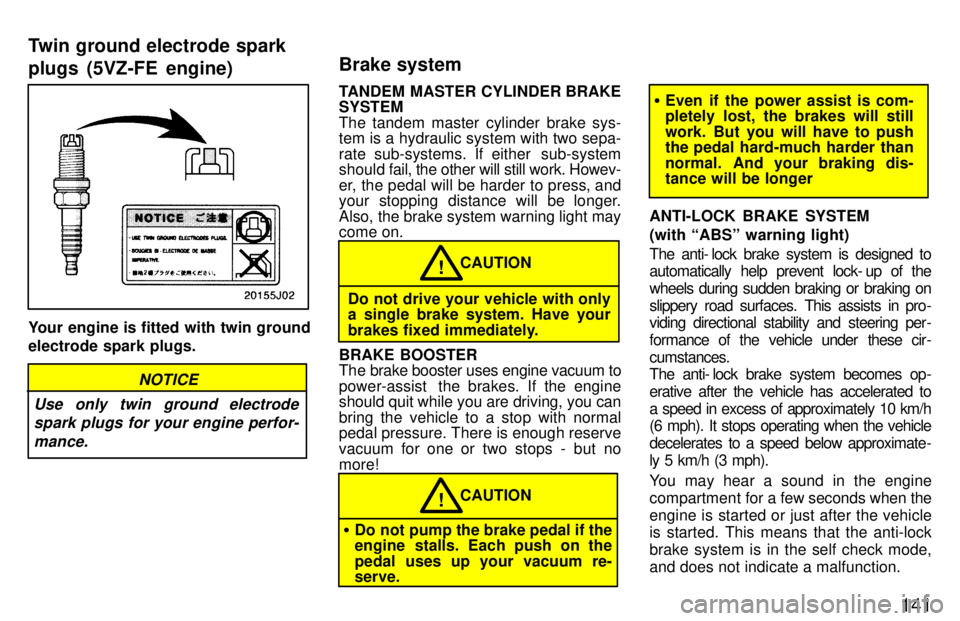
141
Your engine is fitted with twin ground electrode spark plugs.
NOTICE
Use only twin ground electrode spark plugs for your engine perfor-
mance.
TANDEM MASTER CYLINDER BRAKE SYSTEM
The tandem master cylinder brake sys-
tem is a hydraulic system with two sepa-
rate sub-systems. If either sub-system
should fa il, the other will still work. Howev-
er, the pedal will be harder to press, and
your stopping distance will be longer.
Also, the brake system warning light may come on.
CAUTION!
Do not drive your vehicle with only a single brake system. Have your
brakes fixed immediately.
BRAKE BOOSTER
The brake booster uses engine vacuum to
power-assist the brakes. If the engine
should quit while you are driving, you can
bring the vehicle to a stop with normal
pedal pressure. There is enough reserve
vacuum for one or two stops - but nomore!
CAUTION!
� Do not pump the brake pedal if the
engine stalls. Each push on the
pedal uses up your vacuum re- serve.
�Even if the power assist is com-
pletely lost, the brakes will still
work. But you will have to push
the pedal hard-much harder than
normal. And your braking dis- tance will be longer
ANTI-LOCK BRAKE SYSTEM (with ABSº warning light)
The anti- lock brake system is designed to
automatically help prevent lock- up of the
wheels during sudden braking or braking on
slippery road surfaces. This assists in pro-
viding directional stability and steering per -
formance of the vehicle under these cir -
cumstances.
The anti- lock brake system becomes op-
erative after the vehicle has accelerated to
a speed in excess of approximately 10 km/h
(6 mph). It stops operating when the vehicle
decelerates to a speed below approximate-
ly 5 km/h (3 mph).
You may hear a sound in the engine
compartment for a few seconds when the
engine is started or just after the vehicle is started. This means that the anti-lock
brake system is in the self check mode,
and does not indicate a malfunction.
Twin ground electrode spark plugs (5VZ-FE engine)
Brake system
Page 140 of 223

143
ABSº warning light
This light comes on when the ignition key is turned to the ONº position. After about
3 seconds, the light will go off.
When the light is on with the rear dif
feren-
tial locked, it indicates the anti-lock brake
system will not operate.
If either of the following conditions occurs, this indicates a malfunction somewhere inthe parts monitored by the warning light
system. Contact your Toyota dealer as
soon as possible to service the vehicle. � The light does not come on as de-
scribed above, or remains on.
� The light comes on while driving with
the rear differential unlocked.
� The light does not come on with the
rear differential locked.
� The light comes on while driving. Even if the anti-lock brake system
should
fail, the brake system will still operate con-
ventionally. However, when the `ABS''
warning light is on (and the brake system
warning light is off), the anti-lock brake
system is not assisting brake perfor-mance so that the wheels can lock-up
during sudden braking or braking on slip-
pery road surfaces. Have your vehicle
checked by your Toyota dealer as soon as
possible
The brake pads wear limit indicators
on your disc brakes give a warning
noise w hen the brake pads are worn to
where replacement is required.
If you hear a squealing or scraping noise
while driving, have the brake pads
checked and replaced by your Toyota
dealer as soon as possible. Expensive ro-
tor damage can result if the pads are not
replaced when necessary.
Brake pad wear limit indicator
Page 147 of 223
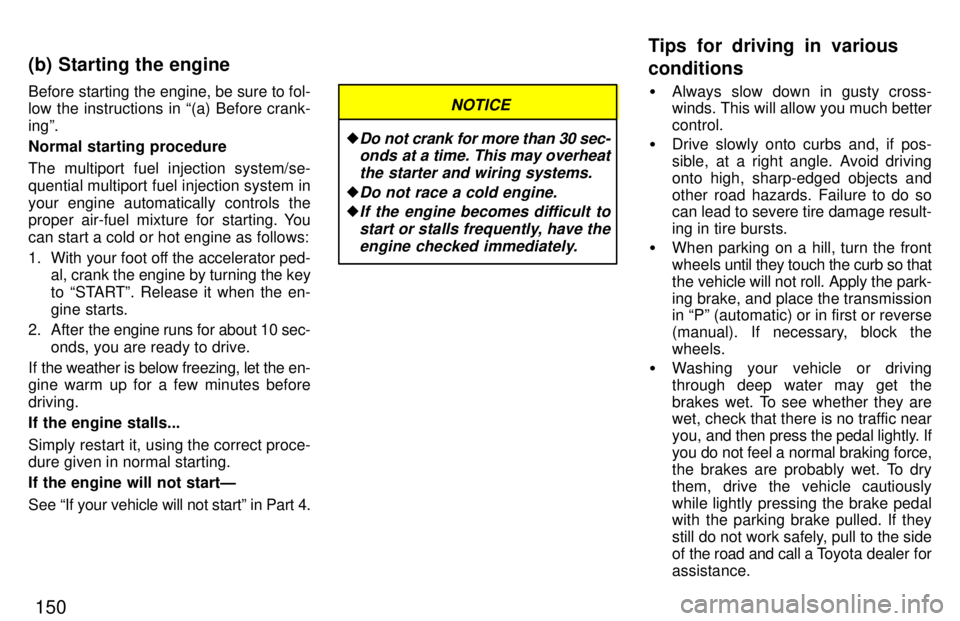
150
Before starting the engine, be sure to fol-
low the instructions in (a) Before crank- ingº.
Normal starting procedure
The multiport fuel injection system/se-
quential multiport fuel injection system in
your engine automatically controls the
proper air-fuel mixture for starting. You can start a cold or hot engine as follows:
1. With your foot off the accelerator ped-
al, crank the engine by turning the key
to STARTº. Release it when the en-
gine starts.
2. After the engine runs for about 10 sec-
onds, you are ready to drive.
If the weather is below freezing, let the en-
gine warm up for a few minutes before driving.
If the engine stalls...
Simply restart it, using the correct proce- dure given in normal starting. If the engine will not startÐ
See If your vehicle will not startº in Part 4. �
Do not crank for more than 30 sec-
onds at a time. This may overheat
the starter and wiring systems.
�Do not race a cold engine.
�If the engine becomes difficult to
start or stalls frequently, have theengine checked immediately.
NOTICE� Always slow down in gusty cross- winds. This will allow you much better control.
� Drive slowly onto curbs and, if pos-
sible, at a right angle. Avoid drivingonto high, sharp-edged objects and
other road hazards. Failure to do so
can lead to severe tire damage result-
ing in tire bursts.
� When parking on a hill, turn the front
wheels until they touch the curb so that
the vehicle will not roll. Apply the park-
ing brake, and place the transmission in Pº (automatic) or in first or reverse
(manual). If necessary, block thewheels.
� Washing your vehicle or driving
through deep water may get the
brakes wet. To see whether they are
wet, check that there is no traffic near
you, and then press the pedal lightly. If
you do not feel a normal braking force,
the brakes are probably wet. To dry
them, drive the vehicle cautiously
while lightly pressing the brake pedal
with the parking brake pulled. If they
still do not work safely, pull to the side
of the road and call a T oyota dealer for
assistance.
(b) Starting the engine
Tips for driving in various conditions
Page 148 of 223
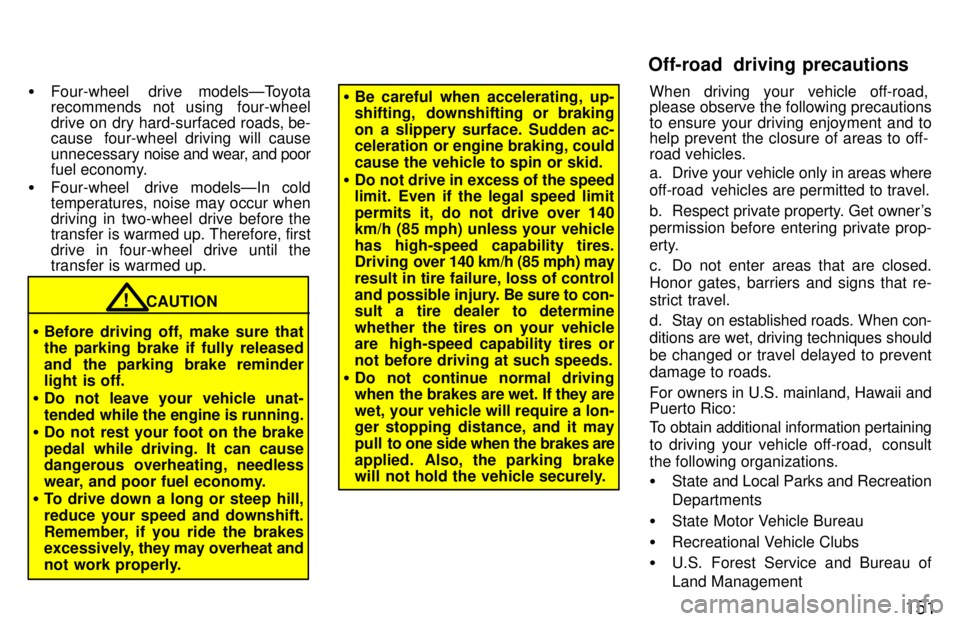
151
�
Four-wheel drive modelsÐToyota
recommends not using four-wheel
drive on dry hard-surfaced roads, be-
cause four-wheel driving will cause unnecessary noise and wear, and poor
fuel economy.
� Four-wheel drive modelsÐIn cold
temperatures, noise may occur when
driving in two-wheel drive before the
transfer is warmed up. Therefore, first
drive in four-wheel drive until the
transfer is warmed up.
CAUTION!
� Before driving off, make sure that the parking brake if fully released
and the parking brake reminder
light is off.
� Do not leave your vehicle unat-
tended while the engine is running.
� Do not rest your foot on the brake
pedal while driving. It can cause
dangerous overheating, needless
wear, and poor fuel economy.
� To drive down a long or steep hill,reduce your speed and downshift.
Remember, if you ride the brakes
excessively, they may overheat and
not work properly.
� Be careful when accelerating, up-
shifting, downshifting or braking
on a slippery surface. Sudden ac-
celeration or engine braking, could cause the vehicle to spin or skid.
� Do not drive in excess of the speed
limit. Even if the legal speed limit
permits it, do not drive over 140
km/h (85 mph) unless your vehicle
has high-speed capability tires.
Driving over 140 km/h (85 mph) may
result in tire failure, loss of control
and possible injury. Be sure to con-
sult a tire dealer to determine
whether the tires on your vehicle
are high-speed capability tires or
not before driving at such speeds.
� Do not continue normal driving
when the brakes are wet. If they are
wet, your vehicle will require a lon-ger stopping distance, and it may
pull to one side when the brakes are
applied. Also, the parking brake
will not hold the vehicle securely. When driving your vehicle off-road,
please observe the following precautions
to ensure your driving enjoyment and to
help prevent the closure of areas to off-
road vehicles.
a. Drive your vehicle only in
areas where
off-road vehicles are permitted to travel.
b. Respect private property. Get owner's
permission before entering private prop-
erty.
c. Do not enter areas that are closed.
Honor gates, barriers and signs that re-
strict travel.
d. Stay on established roads. When con-
ditions are wet, driving techniques should
be changed or travel delayed to prevent
damage to roads.
For owners in U.S. mainland, Hawaii and Puerto Rico:
To obtain additional information pertaining
to driving your vehicle off-road, consult the following organizations. � State and Local Parks and Recreation Departments
� State Motor Vehicle Bureau
� Recreational Vehicle Clubs
� U.S. Forest Service and Bureau of
Land Management
Off-road driving precautions
Page 149 of 223
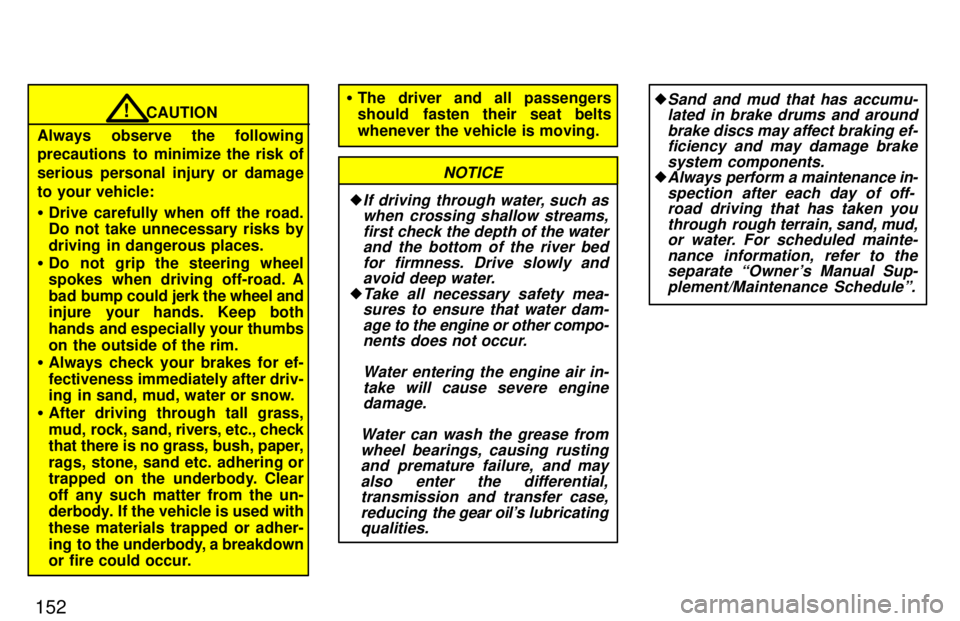
152
CAUTION!
Always observe the following
precautions to minimize the risk of
serious personal injury or damage
to your vehicle: � Drive carefully when off the road. Do not take unnecessary risks by
driving in dangerous places.
� Do not grip the steering wheel
spokes when driving off-road. A
bad bump could jerk the wheel and
injure your hands. Keep both
hands and especially your thumbs
on the outside of the rim.
� Always check your brakes for ef-fectiveness immediately after driv-
ing in sand, mud, water or snow.
� After driving through tall grass,
mud, rock, sand, rivers, etc., check
that there is no grass, bush, paper,
rags, stone, sand etc. adhering or
trapped on the underbody. Clear
off any such matter from the un-
derbody. If the vehicle is used with these materials trapped or adher-
ing to the underbody, a breakdown
or fire could occur.�The driver and all passengers
should fasten their seat belts
whenever the vehicle is moving.
�
If driving through water, such as when crossing shallow streams,
first check the depth of the waterand the bottom of the river bed
for firmness. Drive slowly andavoid deep water.
�Take all necessary safety mea-sures to ensure that water dam-
age to the engine or other compo-nents does not occur.
Water entering the engine air in-take will cause severe enginedamage.
Water can wash the grease fromwheel bearings, causing rustingand premature failure, and may
also enter the differential,transmission and transfer case,
reducing the gear oil's lubricating
qualities.
NOTICE
�Sand and mud that has accumu- lated in brake drums and around
brake discs may affect braking ef-ficiency and may damage brake
system components.
�Always perform a maintenance in-
spection after each day of off-road driving that has taken you
through rough terrain, sand, mud,
or water. For scheduled mainte-
nance information, refer to theseparate Owner's Manual Sup-
plement/Maintenance Scheduleº.
Page 152 of 223
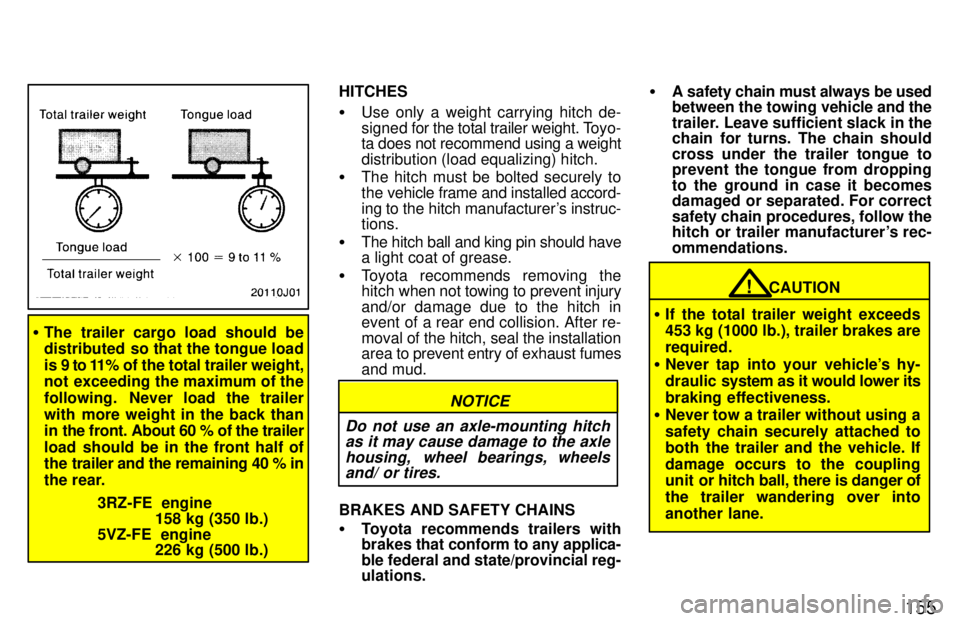
155
�The trailer cargo load should be
distributed so that the tongue load
is 9 to 11% of the total trailer weight,
not exceeding the maximum of the
following. Never load the trailer
with more weight in the back than
in the front. About 60 % of the trailer
load should be in the front half of
the trailer and the remaining 40 % in
the rear.
3RZ-FE engine 158 kg (350 lb.)
5VZ-FE engine 226 kg (500 lb.) HITCHES �
Use only a weight carrying hitch de-
signed for the total trailer weight. Toyo-
ta does not recommend using a weight
distribution (load equalizing) hitch.
� The hitch must be bolted securely to
the vehicle frame and installed accord-
ing to the hitch manufacturer's instruc- tions.
� The hitch ball and king pin should havea light coat of grease.
� Toyota recommends removing thehitch when not towing to prevent injury
and/or damage due to the hitch in
event of a rear end collision. After re- moval of the hitch, seal the installation
area to prevent entry of exhaust fumes
and mud.
Do not use an axle-mounting hitch as it may cause damage to the axle
housing, wheel bearings, wheelsand/ or tires.
NOTICE
BRAKES AND SAFETY CHAINS � Toyota recommends trailers with
brakes that conform to any applica-
ble federal and state/provincial reg-ulations. �
A safety chain must always be used
between the towing vehicle and the
trailer. Leave sufficient slack in the
chain for turns. The chain should cross under the trailer tongue to
prevent the tongue from dropping
to the ground in case it becomes
damaged or separated. For correct
safety chain procedures, follow the
hitch or trailer manufacturer's rec- ommendations.
CAUTION!
� If the total trailer weight exceeds
453 kg (1000 lb.), trailer brakes are required.
� Never tap into your vehicle's hy-
draulic system as it would lower its
braking effectiveness.
� Never tow a trailer without using a
safety chain securely attached to
both the trailer and the vehicle. If
damage occurs to the coupling
unit or hitch ball, there is danger of
the trailer wandering over into
another lane.
Page 154 of 223

157
�
Because stopping distance may be in-
creased, vehicle-to-vehicle distance
should be increased when towing a
trailer. For each 16 km/h (10 mph) of speed, allow at least one vehicle and
trailer length between you and the ve-
hicle ahead. Avoid sudden braking as you may skid, resulting in jackknifing
and loss of control. This is especially
true on wet or slippery surfaces.
� Avoid jerky starts or sudden accelera-tion. If your vehicle has manual trans-
mission, prevent excessive clutch slip-
page by keeping engine rpm low and
not racing the engine. Always start out
in first gear.
� Avoid jerky steering and sharp turns.
The trailer could hit your vehicle in a
tight turn. Slow down before making a
turn to avoid the necessity of sudden braking.
� Remember that when making a turn, the trailer wheels will be closer than the vehicle wheels to the inside of the
turn. Therefore, compensate for this
by making a larger than normal turning
radius with your vehicle. �
Crosswinds and rough roads will ad-
versely affect handling of your vehicle
and trailer, causing sway. Pay atten-
tion to the rear from time to time to pre-
pare yourself for being passed by largetrucks or buses, which may cause your
vehicle and trailer to sway. If swaying
happens, firmly grip the steering wheel
and reduce speed immediately but
gradually. Never increase speed.
Steer straight ahead. If you make no
extreme correction with the steering or
brakes, the vehicle and trailer will sta-bilize.
� Be careful when passing other ve-hicles. Passing requires considerable
distance. After passing a vehicle, do
not forget the length of your trailer and
be sure you have plenty of room be-
fore changing lanes.
� In order to maintain engine braking ef-
ficiency, do not use fifth gear (manual
transmission) or overdrive (automatic transmission). �
Because of the added load of the trail-
er, your vehicle's engine may overheat
on hot days (at temperatures over 30 5C [85 5F]) when going up a long or
steep grade with a trailer. If the engine
coolant temperature gauge indicates
overheating, immediately turn off the
air conditioning (if in use), pull off the
road and stop in a safe spot. Refer to
If your vehicle overheatsº in Part 4 of this manual.
� Always place wheel blocks under both
the vehicle and trailer wheels whenparking. Apply the parking brake firm-
ly. Put the transmission in Pº (auto-
matic) or in first or reverse (manual).
Avoid parking on a slope with a trailer,but if it cannot be avoided, do so only after performing the following:
1. Apply the brakes and hold.
2. Have someone place wheel blocks un-
der both the vehicle and trailer wheels.
3. When the wheel blocks are in place, release your brakes slowly until the blocks absorb the load.
4. Apply the parking brake firmly.
5. Shift into first or reverse (manual) or Pº (automatic) and turn off the engine.